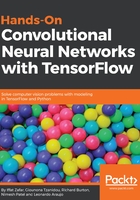
CNN model architecture
The crucial part of an image classification model is its CNN layers. These layers will be responsible for extracting features from image data. The output of these CNN layers will be a feature vector, which like before, we can use as input for the classifier of our choice. For many CNN models, the classifier will be just a fully connected layer attached to the output of our CNN. As shown in Chapter 1, Setup and Introduction to TensorFlow, our linear classifier is just a fully connected layer; this is exactly the case here, except that the size and input to the layer will be different.
It is important to note that at its core, the CNN architecture used in classification or a regression problem such as localization (or any other problems that use images for that matter) would be the same. The only real difference will be what happens after the CNN layers have done their feature extraction. For example, one difference could be the loss function used for different tasks, as it is shown in the following diagram:

You will see a recurring pattern in this book when we look at the different problems that CNNs can be used to solve. It will become apparent that lots of tasks involving images can be solved using a CNN to extract some meaningful feature vector from the input data, which will then be manipulated in some way and fed to different loss functions, depending on the task. For now, let’s crack on and focus firstly on the task of image classification by looking at the loss functions commonly used for it.